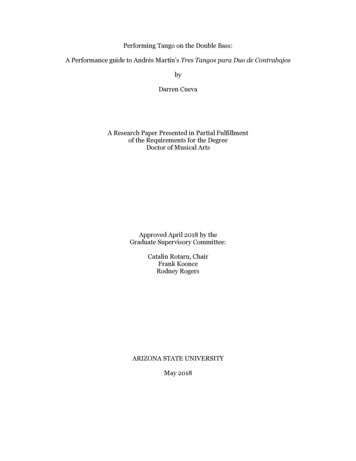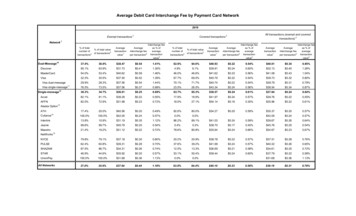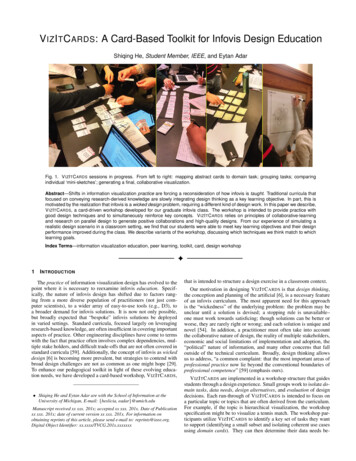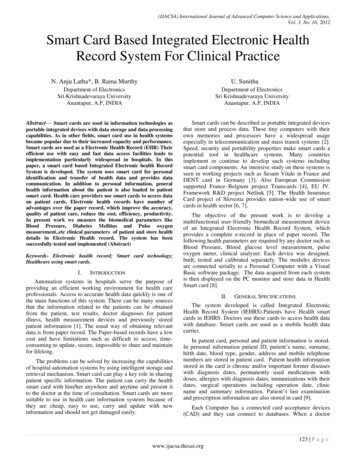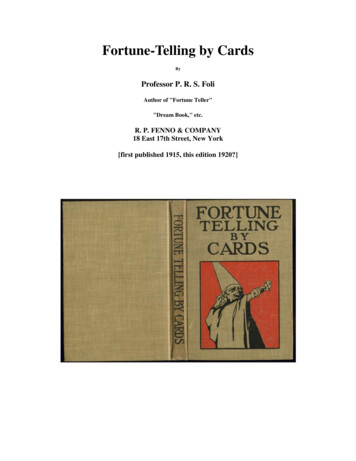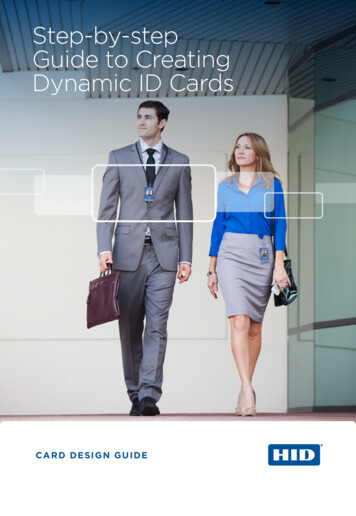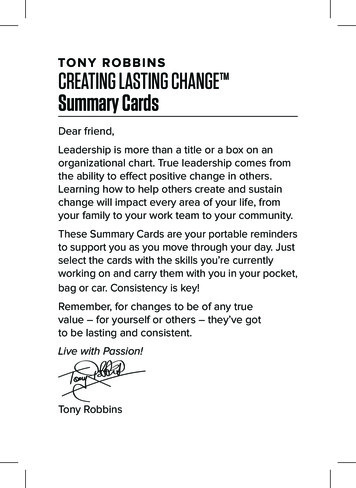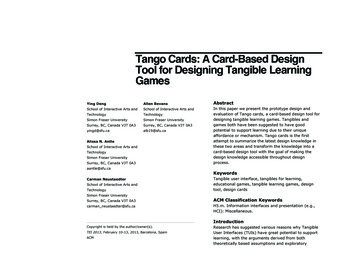
Transcription
Tango Cards: A Card-Based DesignTool for Designing Tangible LearningGamesYing DengAllen BevansAbstractSchool of Interactive Arts andSchool of Interactive Arts andTechnologyTechnologySimon Fraser UniversitySimon Fraser UniversitySurrey, BC, Canada V3T 0A3Surrey, BC, Canada V3T 0A3yingd@sfu.caalb19@sfu.caIn this paper we present the prototype design andevaluation of Tango cards, a card-based design tool fordesigning tangible learning games. Tangibles andgames both have been suggested to have goodpotential to support learning due to their uniqueaffordance or mechanism. Tango cards is the firstattempt to summarize the latest design knowledge inthese two areas and transform the knowledge into acard-based design tool with the goal of making thedesign knowledge accessible throughout designprocess.Alissa N. AntleSchool of Interactive Arts andTechnologySimon Fraser UniversitySurrey, BC, Canada V3T 0A3aantle@sfu.caKeywordsCarman NeustaedterSchool of Interactive Arts andTechnologyTangible user interface, tangibles for learning,educational games, tangible learning games, designtool, design cardsSimon Fraser UniversitySurrey, BC, Canada V3T 0A3ACM Classification Keywordscarman neustaedter@sfu.caH5.m. Information interfaces and presentation (e.g.,HCI): Miscellaneous.IntroductionCopyright is held by the author/owner(s).TEI 2013, February 10-13, 2013, Barcelona, SpainACMResearch has suggested various reasons why TangibleUser Interfaces (TUIs) have great potential to supportlearning, with the arguments derived from boththeoretically based assumptions and exploratory
2empirical studies. For example, the everyday, concretephysical form of TUIs is natural and enables learners toleverage their real-world knowledge to helpunderstanding [15]. The physical manipulation involvedin tangible interaction supports offloading thinking toactions on physical objects and thus facilitates problemsolving [2].The properties and/or interaction with thephysical manipulative may provide metaphorical linkingto help understand abstract concepts [12]. TUIs alsohave been claimed to have unique benefits insupporting collaboration with a design of shared spaceand controls [2,15].Meanwhile, there has been increasing interest ininvestigating how to design effective educational gamesto make learning intrinsically motivating and engaging.For examples, Gee analyzed the learning principlesbehind good video games that make them motivating[7,8]. Fisch put forward design considerations abouthow to effectively integrate educational content intogame play from his experience designing learninggames [6]. Castell and Jenson explored how to enactludic epistemology to design “content-free” educationalgames with learning information distributed among themultiple modalities afforded by digital media [5].We propose that tangible learning games, whichharness the unique affordance and learningopportunities provided by TUIs and the good learningprinciples inherent in good games, should be apromising approach to support learning. Tangiblelearning games are still a new concept and findthemselves mostly as research prototypes, asexemplified by Kurio [14], an interactive hybrid system(TUIs and GUIs) that utilizes tangible objects and gamemechanism to support the social interaction andlearning of families visiting a museum. There are moreexisting tangible learning prototypes, which may notmeet the strict definition of games, by do enact playfullearning [5], as exemplified by Flowblocks [15].Although it seems that a majority of current tangiblelearning games/systems are designed for children,there is no reason why adult learners cannot benefitfrom them in formal and informal learning settings. Thelearning domains that tangible learning games fit in arenot limited either, e.g., math, science, music, andgeneral abstract concepts (such as sustainability), toname just a few.Design frameworks and loose design principles havebeen developed to structure thinking and practice oftangible learning design (e.g., [1]) and learning gamedesign (e.g., [6,7,8]). However, such knowledge isabstract and dense, which make it difficult to use indesign practice. Rogers suggests that to enable designtheory to best inform design, a focus on the designprocess is important [13]. Therefore, what is needed isa design tool that bridges this gap and makes designknowledge accessible to design process.This paper presents the design and evaluation of Tangocards, a card-based design tool for designing tangiblelearning games, as an initial effort to bridge this gap.Tango cards have the potential to encourage theapplication of the design knowledge to the designpractice of tangible learning games, which in turn canfoster the validation and refinement of the designtheories.The research questions we want to investigate throughour research instrument of Tango cards are:
3 Are cards an effective design tool in makingdesign knowledge about TUI for learning andlearning games more accessible to designersduring their design practice? How do designers use Tango cards in differentdesign activities? For what purpose and inwhich situations are the cards most useful? How do the specific design features of theTango cards (e.g., presentation, form, content)enable or limit such use?Cards as a Design ToolDesign cards are small paper cards with text andpictures on them that concisely present a knowledgedomain as sources of inspiration and/or informationduring design process. Our approach of using cards asa design tool was informed and inspired by previouswork that transformed design frameworks orconceptual information into design cards to make thesource knowledge accessible in design process[3,10,11]. According to the findings of previous work[3,9,10], small physical cards enable designers tofreely move and arrange the cards to externalize theirideas and to orient team members to their ideas, thusmaking arguments tangible during a design discussion(see figure 6). Cards can help structure designdiscussions, ensuring the “design space is viewed fromdifferent perspectives and informed by a framework.”When a discussion becomes unproductive, cards canfoster the shift of focus to unstuck the discussion.Cards can also be used to evaluate design.Literature Sources of Tango CardsThe literature source of Tango cards covers twocategories: TUIs for learning and games for learning.Tangible Learning Design FrameworkThe considerations about designing tangibles forlearning were transformed from the Tangible LearningDesign Framework by Antle and Wise [1]. Thisframework is the first attempt of an explanatorytangible learning design framework, and represents themost current effort to provide design guidelines fortangibles for learning. It aims to fill the knowledge gapby providing specific, testable mechanisms by whichthe unique affordances of TUIs might facilitate learning.In this framework, the authors identify five importantelements for TUI learning design (physical objects,digital objects, actions on objects, informationalrelations, and learning activities). The authors thenpropose 13 design guidelines from cognition andlearning theories to inform the design of theseelements. Empirical examples are provided to supportguidelines when available. This framework can helpdesigners make predictable design decisions andevaluate design analytically.Design principles/considerations for learning gamesCurrently there is no design framework for learninggames. Instead we extracted learning game designprinciples/considerations from mainly two sources: theprinciples of learning that Gee found by analyzing goodvideo games through cognitive scientist lenses [7,8],and design considerations that Fisch summarized fromhis research and design experience about educationalgames [6].
4Designing the Tango CardsFigure 1. Example Tango card: Tangiblecategory, text sideFigure 2. Example Tango card: Tangiblecategory, image sideThe design goal of Tango cards is to make knowledgeabout designing tangible learning games accessible andusable to designers during their design process. UnlikeHornecker’s card brainstorming game that shetransformed from her Tangible Learning Framework[10], which focuses on inspiring the design discussionin early design phase and allows free interpretation, wewant our Tango cards to both inform and inspire designin a variety of design activities throughout designprocess. We care about the cards’ ability to effectivelycommunicate the original design knowledge more thanthe cards’ innovation power. We assume that most ofthe users of Tango cards, i.e., design researchers andstudents (and future users of design practitioners),have experience and knowledge with some aspects ofthe design domain of tangible learning games, but notall. We want to make sure that the informationpresented by both the tangible and game categories ofTango cards makes sense to all users. We made thedesign decisions described below with these goals andrequirements in mind.Design ProcessBased on our design goal and the design knowledgecontributed by other researchers who designed cards asa design tool or design research tool [3,10,11,16], wedesigned Tango cards through an iterative designprocess. We then conducted an expert review to gatherfeedback on card content and design. Four researchers,including three PhD students and one senior researcherwith expertise in TUIs, game design, or learning scienceparticipated in the review. We revised our cards basedon their feedback. The final design is a set of 25 cards(a PDF copy of the cards can be downloaded fromhttp://www.sfu.ca/ yingd/tangocards.zip).Developing Card ContentWe distilled considerations, explanations, and examplesfrom the literature described earlier and transformedthem into more concrete and pragmatic information insimpler language. Such transformation aims to makethe information more accessible and usable todesigners. For example, for the “Simple input actions”card of the tangible category, the original designguideline in the Tangible Learning Design Framework is“Leveraging image schemas in input actions canimprove usability and system learnability”. Werephrased it to “Does the TUI use simple, commonmovement patterns, like in-out, up-down, and fastslow, for input actions?”Tango Cards DesignTango cards consist of two categories: tangible cardsand game cards. The design considerations for bothTUIs and games are learning-oriented. The cards arecolor-coded by categories: blue color for the 11tangible learning cards (figure 1 and 2), and orangecolor for the 14 game cards (figure 3 and 4).Each Tango card has two sides: the front text side andthe back image side. The front side (figure 1 and 3)contains five parts: title, design consideration,rationale, textual example, and a label “Tango Cards –Tangible, Learning, Games” in the order from top tobottom of a card. The design considerations are phasedin a provocative question format as inspired by [10].The rationale part explains what benefits suchconsideration can bring, mostly from the learningperspective. The text example briefly describes apractice or technique that reflects this consideration.
5The spatial order as well as the font hierarchy of theelements on the front side of a card corresponds withtheir order of importance to card use. We want users tocatch the core information; that is, title andconsideration on their first sight on a card; and theycan choose to continue reading the card if they needfurther information. This feature supports users ofdifferent levels of familiarity with the design knowledge.After users get familiar with the concepts, they mightneed to look at only the title and consideration question(or only the title) to remind themselves of the concept.Large title font size also enables users to read and referto a card from a distance. The examples can facilitateunderstanding the concept as well as provide users withdesign ideas.Figure 3. Example Tango card: Gamecategory, text sideFigure 4. Example Tango card:Game category, image sideThe back of a card (figure 2 and 4) contains the cardtitle and images examples. Similar to the text exampleson the front side, we anticipated users to use the imageexample to gain a more concrete understanding of thedesign concept as well as for inspiration. In addition,the image example can serve as a visual shortcut for aspecific card, especially after users become familiarwith the cards. We also wanted to add a QR codelinking to detailed information about the prototype(e.g., publications and videos), but this was notimplemented and the QR code image on each card isjust a placeholder. (In our user studies, we askedparticipants to ask us for access to further informationif they wanted to.)Choosing Image ExamplesWe decided to use images of existing prototypes(learning games or systems with tangible interfaces oron other platforms, such as multi-touch tabletop,interactive environment, and computer) to illustrate thedesign considerations if any is available. We did useexamples of human activities (e.g., building a treehouse for the “Relating skills to goals” card) ordiagrams (e.g., the “Feedback as scaffold” card)occasionally when we decided they were a better fit forthe specific cards than any prototype examples wewere able to find. We preferred examples of specificprototypes to more general examples because we feltthat such prototype pictures would inform and inspiredesigners more directly regarding how to apply adesign consideration about tangible learning games [9].We thought such direct, specific examples wereespecially important for the design domain of tangiblelearning games, as it is still a new concept to manytarget users. We also felt that such prototype exampleswould serve a quick learning and research tool fordesigners when they work on their own.However, we do admit that such specific prototypeexamples may require more contextual information andexplanation to make sense. Moreover, the relativelyshort conceptual distance betwe
Tango Cards: A Card-Based Design Tool for Designing Tangible Learning Games Abstract In this paper we present the prototype design and evaluation of Tango cards, a card-based design tool for designing tangible learning games. Tangibles and games both have been suggested to have good potential to support learning due to their unique
